Impact of Land Use Changes on Ecosystem Services Supply: A Meta Analysis of the Italian Context
Abstract
:1. Introduction
1.1. Background
1.2. ES Evaluation Methodologies: A Synthesis
1.3. The Issues and Innovation of the Study
2. Materials and Methods
2.1. Study Area
2.2. Literature Review (Step 1)
2.3. Selection of Biophysical and Economic Coefficients and Implementation of the Database (Step 2)
2.4. Determination of Biophysical and Economic Coefficients (Step 3)
2.5. Assessment of ES Supply (1990–2018) (Step 4)
3. Results
3.1. Literature Review
3.2. Determination of Biophysical and Economic Coefficients
3.3. ES Supply in the Years Investigated and Their Variation
3.4. Economic Variation of ES Supply Concerning the Permanence and Transitions Categories
4. Discussion
Limitations of the Study and Future Steps
5. Conclusions
Author Contributions
Funding
Data Availability Statement
Conflicts of Interest
Appendix A
| ES | Sources | Biophysical Coefficient | Economic Coefficient | Study Area |
|---|---|---|---|---|
| Food production | Council for Agricultural Research and Economics, 2022 [52] | ✕ | ✕ | Italy |
| Forage production | Schirpke et al., 2015 [101] | ✕ | ✕ | Natura 2000 Sites (Italy) |
| Marino et al., 2021 [2] | ✕ | ✕ | National Parks (Italy) | |
| Tardieu et al., 2015 [102] | ✕ | ✕ | Natural and semi-natural areas (France) | |
| Timber supply | Grilli et al., 2015 [103] | ✕ | Italian Alps | |
| Häyhä et al., 2015 [36] | ✕ | ✕ | Alpine forests (Italy) | |
| Vysna et al., 2019 [100] | ✕ | ✕ | Europe | |
| Pedroso et al., 2018 [104] | ✕ | Natural Park of Serra de São Mamede, Portugal | ||
| Bernetti et al., 2013 [105] | ✕ | Forest area of Tuscany (Italy) | ||
| Pettenella et al., 2021 [106] | ✕ | Forests in the Veneto region (Italy) | ||
| Hein et al., 2011 [107] | ✕ | ✕ | Hoge Veluwe protected forest (Netherlands) | |
| White, 2015 [108] | ✕ | ✕ | Protected areas in England and Scotland | |
| Marchetti et al., 2018 [109] | ✕ | ✕ | Italians forest | |
| Mushrooms supply | Schirpke et al., 2015 [101] | ✕ | ✕ | Natura 2000 Sites (Italy) |
| Bernetti et al., 2013 [105] | ✕ | ✕ | Toscana Region (Italy) | |
| Global climate regulation | De Jong et al., 2016 [110] | ✕ | Limburg Province (Netherlands) | |
| Remme et al., 2016 [111] | ✕ | Limburg Province (Netherlands) | ||
| Marino et al., 2021 [2] | ✕ | ✕ | National Parks (Italy) | |
| Schirpke et al., 2015 [101] | ✕ | ✕ | Natura 2000 Sites (Italy) | |
| Morri et al., 2014 [83] | ✕ | ✕ | Apennines and coastal areas (Italy) | |
| Häyhä et al., 2015 [36] | ✕ | ✕ | Alpine forests (Italy) | |
| Cervelli et al., 2022 [112] | ✕ | Vesuvius National Park (Italy) | ||
| Paletto et al., 2015 [113] | ✕ | Austrian Alps | ||
| Bernetti et al., 2013 [105] | ✕ | Forest area of Tuscany (Italy) | ||
| White, 2015 [108] | ✕ | ✕ | Protected areas in England and Scotland | |
| Willis et al., 2003 [114] | ✕ | Forests (Great Britain) | ||
| Xue et al., 2001 [115] | ✕ | ✕ | Changbaishan Mountain Biosphere Reserve (Northeast China) | |
| Marino et al., eds (2023) [60] | ✕ | ✕ | Monte Amiata e Mugello, Toscana (Italy) | |
| Marino et al., eds (2023) [116] | ✕ | ✕ | Città metropolitana Roma Capitale (Italy) | |
| Air purification | De Jong et al., 2016 [110] | ✕ | Limburg Province (Netherlands) | |
| Remme et al., 2016 [111] | ✕ | Limburg Province (Netherlands) | ||
| Duarte et al., 2021 [117] | ✕ | Salt marsh plant species of six Portuguese transitional systems | ||
| Marino et al., 2021 [2] | ✕ | ✕ | National Parks (Italy) | |
| Bottalico et al., 2016 [54] | ✕ | Florence (Italy) | ||
| Manes et al., 2014 [53] | ✕ | Rome (Italy) | ||
| Hein, 2011 [107] | ✕ | ✕ | Hoge Veluwe protected forest (Netherlands) | |
| White, 2015 [108] | ✕ | ✕ | Protected areas in England and Scotland | |
| Marino et al., eds (2023) [60] | ✕ | ✕ | Monte Amiata e Mugello, Toscana (Italy) | |
| Water regulation | De Jong, 2016 [110] | ✕ | Limburg Province (Netherlands) | |
| Remme, 2016 [111] | ✕ | Limburg Province (Netherlands) | ||
| Duarte et al., 2021 [117] | ✕ | Salt marsh plant species of six Portuguese transitional systems | ||
| Schirpke et al., 2015 [101] | ✕ | Natura 2000 Sites (Italy) | ||
| Bernetti et al., 2013 [105] | ✕ | Toscana Region (Italy) | ||
| Hein et al., 2011 [107] | ✕ | ✕ | Hoge Veluwe protected forest (Netherlands) | |
| Esen et al., 2023 [118] | ✕ | ✕ | Forest in Southern Aegean region of Turkey | |
| Xue et al., 2001 [115] | ✕ | ✕ | Changbaishan Mountain Biosphere Reserve (Northeast China) | |
| Water purification | Duarte et al., 2021 [117] | ✕ | Salt marsh plant species of six Portuguese transitional systems | |
| Marino et al., eds (2023) [60] | ✕ | ✕ | Monte Amiata e Mugello, Toscana (Italy) | |
| Marino (eds), 2023 [116] | ✕ | ✕ | Città metropolitana Roma Capitale (Italy) | |
| Piaggio et al., 2021 [119] | ✕ | Forest areas (Costa Rica) | ||
| Mueller et al., 2014 [120] | ✕ | Forest in northern Arizona (USA) | ||
| De la Cruz et al., 2009 [121] | ✕ | Pico da Vara Special Protected Area (Portugal) | ||
| Matero et al., 2007 [122] | ✕ | Finnish forests (Finland) | ||
| Erosion protection | Esen et al., 2023 [118] | ✕ | ✕ | Forest in Southern Aegean region of Turkey |
| Duarte et al., 2021 [117] | ✕ | Salt marsh plant species of six Portuguese transitional systems | ||
| Schirpke et al., 2015 [101] | ✕ | ✕ | Natura 2000 Sites (Italy) | |
| Marino et al., eds (2023) [60] | ✕ | ✕ | Monte Amiata e Mugello, Toscana (Italy) | |
| Mastrorilli et al., 2018 [123] | ✕ | ✕ | Calabria Region, Italy | |
| Morri et al., 2014 [83] | ✕ | ✕ | Apennines and coastal areas (Italy) | |
| Häyhä et al., 2015 [36] | ✕ | Alpine forests (Italy) | ||
| Pedroso et al., 2018 [104] | ✕ | Natural Park of Serra de São Mamede, Portugal | ||
| Xue et al., 2001 [115] | ✕ | Changbaishan Mountain Biosphere Reserve (Northeast China) | ||
| Flood risk mitigation | Esen et al., 2023 [118] | ✕ | Forest in Southern Aegean region of Turkey | |
| Duarte et al., 2021 [117] | ✕ | Salt marsh plant species of six Portuguese transitional systems | ||
| Marino et al., eds (2023) [60] | ✕ | ✕ | Monte Amiata e Mugello, Toscana (Italy) | |
| Morri et al., 2014 [83] | ✕ | ✕ | Apennines and coastal areas (Italy) | |
| Mastrorilli et al., 2018 [123] | ✕ | ✕ | Calabria Region, Italy | |
| Marino et al., 2023 [49] | ✕ | ✕ | Città metropolitana Roma Capitale (Italy) | |
| Broadmeadow et al., 2018 [124] | ✕ | Forest in Great Britain (GB) |
References
- Steffen, W.; Crutzen, P.J.; McNeill, J.R. The Anthropocene: Are Humans Now Overwhelming the Great Forces of Nature? Ambio 2007, 36, 614–621. Available online: http://www.jstor.org/stable/25547826 (accessed on 30 March 2023). [CrossRef] [PubMed]
- Marino, D.; Palmieri, M.; Marucci, A.; Tufano, M. Comparison between Demand and Supply of Some Ecosystem Services in National Parks: A Spatial Analysis Conducted Using Italian Case Studies. Conservation 2021, 1, 36–57. [Google Scholar] [CrossRef]
- Ellis, E.C.; Goldewijk, K.K.; Siebert, S.; Lightman, D.; Ramankutty, N. Anthropogenic Transformation of the Biomes, 1700 to 2000. Glob. Ecol. Biogeogr. 2010, 19, 589–606. [Google Scholar] [CrossRef]
- Fang, Z.; Ding, T.; Chen, J.; Xue, S.; Zhou, Q.; Wang, Y.; Wang, Y.; Huang, Z.; Yang, S. Impacts of Land Use/Land Cover Changes on Ecosystem Services in Ecologically Fragile Regions. Sci. Total Environ. 2022, 831, 154967. [Google Scholar] [CrossRef] [PubMed]
- Hasan, S.S.; Zhen, L.; Miah, M.G.; Ahamed, T.; Samie, A. Impact of Land Use Change on Ecosystem Services: A Review. Environ. Dev. 2020, 34, 100527. [Google Scholar] [CrossRef]
- Zhang, Z.; Liu, Y.; Wang, Y.; Liu, Y.; Zhang, Y.; Zhang, Y. What Factors Affect the Synergy and Tradeoff between Ecosystem Services, and How, from a Geospatial Perspective? J. Clean. Prod. 2020, 257, 120454. [Google Scholar] [CrossRef]
- Davison, C.W.; Rahbek, C.; Morueta-Holme, N. Land-Use Change and Biodiversity: Challenges for Assembling Evidence on the Greatest Threat to Nature. Glob. Chang. Biol. 2021, 27, 5414–5429. [Google Scholar] [CrossRef]
- IPBES. Summary for Policymakers of the Global Assessment Report on Biodiversity and Ecosystem Services; IPBES: Bonn, Germany, 2019; Volume 45, ISBN 9783947851133. [Google Scholar]
- Beckmann, M.; Gerstner, K.; Akin-Fajiye, M.; Ceaușu, S.; Kambach, S.; Kinlock, N.L.; Phillips, H.R.P.; Verhagen, W.; Gurevitch, J.; Klotz, S.; et al. Conventional Land-Use Intensification Reduces Species Richness and Increases Production: A Global Meta-Analysis. Glob. Chang. Biol. 2019, 25, 1941–1956. [Google Scholar] [CrossRef]
- Gerstner, K.; Dormann, C.F.; Stein, A.; Manceur, A.M.; Seppelt, R. Effects of Land Use on Plant Diversity—A Global Meta-Analysis. J. Appl. Ecol. 2014, 51, 1690–1700. [Google Scholar] [CrossRef]
- Newbold, T.; Hudson, L.N.; Hill, S.L.L.; Contu, S.; Gray, C.L.; Scharlemann, J.P.W.; Börger, L.; Phillips, H.R.P.; Sheil, D.; Lysenko, I.; et al. Global Patterns of Terrestrial Assemblage Turnover within and among Land Uses. Ecography 2016, 39, 1151–1163. [Google Scholar] [CrossRef]
- Aronson, M.F.J.; La Sorte, F.A.; Nilon, C.H.; Katti, M.; Goddard, M.A.; Lepczyk, C.A.; Warren, P.S.; Williams, N.S.G.; Cilliers, S.; Clarkson, B.; et al. A Global Analysis of the Impacts of Urbanization on Bird and Plant Diversity Reveals Key Anthropogenic Drivers. Proc. R. Soc. B Biol. Sci. 2014, 281, 20133330. [Google Scholar] [CrossRef] [PubMed]
- Murphy, G.E.P.; Romanuk, T.N. A Meta-Analysis of Declines in Local Species Richness from Human Disturbances. Ecol. Evol. 2014, 4, 91–103. [Google Scholar] [CrossRef] [PubMed]
- Admasu, S.; Yeshitela, K.; Argaw, M. Impact of Land Use Land Cover Changes on Ecosystem Service Values in the Dire and Legedadi Watersheds, Central Highlands of Ethiopia: Implication for Landscape Management Decision Making. Heliyon 2023, 9, e15352. [Google Scholar] [CrossRef] [PubMed]
- Benítez, F.L.; Mena, C.F.; Zurita-Arthos, L. Urban Land Cover Change in Ecologically Fragile Environments: The Case of the Galapagos Islands. Land 2018, 7, 21. [Google Scholar] [CrossRef]
- Burkhard, B.; Kroll, F.; Müller, F.; Windhorst, W. Landscapes’ Capacities to Provide Ecosystem Services—A Concept for Land-Cover Based Assessments. Landsc. Online 2009, 15, 1–22. [Google Scholar] [CrossRef]
- Sharma, R.; Rimal, B.; Baral, H.; Nehren, U.; Paudyal, K.; Sharma, S.; Rijal, S.; Ranpal, S.; Acharya, R.P.; Alenazy, A.A.; et al. Impact of Land Cover Change on Ecosystem Services in a Tropical Forested Landscape. Resources 2019, 8, 18. [Google Scholar] [CrossRef]
- Hailu, A.; Mammo, S.; Kidane, M. Dynamics of Land Use, Land Cover Change Trend and Its Drivers in Jimma Geneti District, Western Ethiopia. Land Use Policy 2020, 99, 105011. [Google Scholar] [CrossRef]
- Maes, J.; Liquete, C.; Teller, A.; Erhard, M.; Paracchini, M.L.; Barredo, J.I.; Grizzetti, B.; Cardoso, A.; Somma, F.; Petersen, J.E.; et al. An Indicator Framework for Assessing Ecosystem Services in Support of the EU Biodiversity Strategy to 2020. Ecosyst. Serv. 2016, 17, 14–23. [Google Scholar] [CrossRef]
- Potschin, M.B.; Haines-Young, R.H. Ecosystem Services: Exploring a Geographical Perspective. Prog. Phys. Geogr. 2011, 35, 575–594. [Google Scholar] [CrossRef]
- Costanza, R.; D’Arge, R.; de Groot, R.; Farber, S.; Grasso, M.; Hannon, B.; Limburg, K.; Naeem, S.; O’Neill, R.V.; Paruelo, J.; et al. The Value of the World’s Ecosystem Services and Natural Capital. Ecol. Econ. 1998, 25, 3–15. [Google Scholar] [CrossRef]
- Costanza, R.; de Groot, R.; Sutton, P.; van der Ploeg, S.; Anderson, S.J.; Kubiszewski, I.; Farber, S.; Turner, R.K. Changes in the Global Value of Ecosystem Services. Glob. Environ. Chang. 2014, 26, 152–158. [Google Scholar] [CrossRef]
- De Vreese, R.; Leys, M.; Fontaine, C.M.; Dendoncker, N. Social Mapping of Perceived Ecosystem Services Supply-The Role of Social Landscape Metrics and Social Hotspots for Integrated Ecosystem Services Assessment, Landscape Planning and Management. Ecol. Indic. 2016, 66, 517–533. [Google Scholar] [CrossRef]
- Plieninger, T.; Dijks, S.; Oteros-Rozas, E.; Bieling, C. Assessing, Mapping, and Quantifying Cultural Ecosystem Services at Community Level. Land Use Policy 2013, 33, 118–129. [Google Scholar] [CrossRef]
- van Riper, C.J.; Kyle, G.T.; Sutton, S.G.; Barnes, M.; Sherrouse, B.C. Mapping Outdoor Recreationists’ Perceived Social Values for Ecosystem Services at Hinchinbrook Island National Park, Australia. Appl. Geogr. 2012, 35, 164–173. [Google Scholar] [CrossRef]
- Burkhard, B.; Kandziora, M.; Hou, Y.; Müller, F. Ecosystem Service Potentials, Flows and Demands-Concepts for Spatial Localisation, Indication and Quantification. Landsc. Online 2014, 34, 1–32. [Google Scholar] [CrossRef]
- Schirpke, U.; Tasser, E. Trends in Ecosystem Services across Europe Due to Land-Use/Cover Changes. Sustainability 2021, 13, 7095. [Google Scholar] [CrossRef]
- Ongsomwang, S.; Pattanakiat, S.; Srisuwan, A. Impact of Land Use and Land Cover Change on Ecosystem Service Values: A Case Study of Khon Kaen City, Thailand. Environ. Nat. Resour. J. 2019, 17, 43–58. [Google Scholar] [CrossRef]
- Wang, H.; Lü, Z.; Gu, L.; Wen, C.; Palomo-Campesino, S.; García-Llorente, M.; Hevia, V.; Boeraeve, F.; Dendoncker, N.; González, J.A.; et al. Linking Flood Risk Mitigation and Food Security: An Analysis of Land-Use Change in the Metropolitan Area of Rome. Ecosyst. Serv. 2021, 11, 1–23. [Google Scholar]
- Assefa, G.; Kijora, C.; Kehaliew, A.; Sonder, K.; Peters, K.J. Effect of Pre-Feeding Forage Treatments, Harvesting Stage, and Animal Type on Preference of Tagasaste (Chamaecytisus palmensis). Agrofor. Syst. 2012, 84, 25–34. [Google Scholar] [CrossRef]
- Gashaw, T.; Tulu, T.; Argaw, M.; Worqlul, A.W. Evaluation and Prediction of Land Use/Land Cover Changes in the Andassa Watershed, Blue Nile Basin, Ethiopia. Environ. Syst. Res. 2017, 6, 17. [Google Scholar] [CrossRef]
- Berihun, M.L.; Tsunekawa, A.; Haregeweyn, N.; Meshesha, D.T.; Adgo, E.; Tsubo, M.; Masunaga, T.; Fenta, A.A.; Sultan, D.; Yibeltal, M. Exploring Land Use/Land Cover Changes, Drivers and Their Implications in Contrasting Agro-Ecological Environments of Ethiopia. Land Use Policy 2019, 87, 104052. [Google Scholar] [CrossRef]
- Ciocănea, C.M.; Sorescu, C.; Ianoşi, M.; Bagrinovschi, V. Assessing Public Perception on Protected Areas in Iron Gates Natural Park. Procedia Environ. Sci. 2016, 32, 70–79. [Google Scholar] [CrossRef]
- Lin, J.; Huang, J.; Prell, C.; Bryan, B.A. Changes in Supply and Demand Mediate the Effects of Land-Use Change on Freshwater Ecosystem Services Flows. Sci. Total Environ. 2021, 763, 143012. [Google Scholar] [CrossRef] [PubMed]
- Chen, W.; Zhao, H.; Li, J.; Zhu, L.; Wang, Z.; Zeng, J. Land Use Transitions and the Associated Impacts on Ecosystem Services in the Middle Reaches of the Yangtze River Economic Belt in China Based on the Geo-Informatic Tupu Method. Sci. Total Environ. 2020, 701, 134690. [Google Scholar] [CrossRef] [PubMed]
- Häyhä, T.; Franzese, P.P.; Paletto, A.; Fath, B.D. Assessing, Valuing, and Mapping Ecosystem Services in Alpine Forests. Ecosyst. Serv. 2015, 14, 12–23. [Google Scholar] [CrossRef]
- Urbina-Cardona, N.; Cardona, V.O.; Cuellar, S. Uncovering Thematic Biases in Ecosystem Services Mapping: Knowledge Shortfalls and Challenges for Use in Conservation. Biol. Conserv. 2023, 283, 110086. [Google Scholar] [CrossRef]
- Leal Filho, W.; Azeiteiro, U.M.; Balogun, A.L.; Setti, A.F.F.; Mucova, S.A.R.; Ayal, D.; Totin, E.; Lydia, A.M.; Kalaba, F.K.; Oguge, N.O. The Influence of Ecosystems Services Depletion to Climate Change Adaptation Efforts in Africa. Sci. Total Environ. 2021, 779, 146414. [Google Scholar] [CrossRef]
- Brouwer, R. Environmental Value Transfer: State of the Art and Future Prospects. Ecol. Econ. 2000, 32, 137–152. [Google Scholar] [CrossRef]
- Desvousges, W.H.; Naughton, M.C.; Parsons, G.R. Benefit Transfer: Conceptual Problems in Estimating Water Quality Benefits Using Existing Studies. Water Resour. Res. 1992, 28, 675–683. [Google Scholar] [CrossRef]
- Bateman, I.J.; Brouwer, R.; Ferrini, S.; Schaafsma, M.; Barton, D.N.; Dubgaard, A.; Hasler, B.; Hime, S.; Liekens, I.; Navrud, S.; et al. Making Benefit Transfers Work: Deriving and Testing Principles for Value Transfers for Similar and Dissimilar Sites Using a Case Study of the Non-Market Benefits of Water Quality Improvements Across Europe. Environ. Resour. Econ. 2011, 50, 365–387. [Google Scholar] [CrossRef]
- Rosenberger, R.S.; Stanley, T.D. Measurement, Generalization, and Publication: Sources of Error in Benefit Transfers and Their Management. Ecol. Econ. 2006, 60, 372–378. [Google Scholar] [CrossRef]
- Boutwell, J.L.; Westra, J.V. Benefit Transfer: A Review of Methodologies and Challenges. Resources 2013, 2, 517–527. [Google Scholar] [CrossRef]
- Richardson, L.; Loomis, J.; Kroeger, T.; Casey, F. The Role of Benefit Transfer in Ecosystem Service Valuation. Ecol. Econ. 2015, 115, 51–58. [Google Scholar] [CrossRef]
- Ecosystem Services Valuation Database. Available online: https://www.esvd.info/ (accessed on 8 August 2023).
- The Environmental Valuation Reference. Inventory. Available online: https://evri.ca/en (accessed on 8 August 2023).
- INCA Platform. Available online: https://ecosystem-accounts.jrc.ec.europa.eu/ (accessed on 8 August 2023).
- Marino, D.; Palmieri, M.; Marucci, A.; Pili, S. Long-Term Land Cover Changes and Ecosystem Services Variation: Have the Anthropogenic Transformations Degraded Human Well-Being in Italy? Ital. Rev. Agric. Econ. 2022, 77, 7–23. [Google Scholar] [CrossRef]
- Marino, D.; Palmieri, M.; Marucci, A.; Soraci, M.; Barone, A.; Pili, S. Linking Flood Risk Mitigation and Food Security: An Analysis of Land-Use Change in the Metropolitan Area of Rome. Land 2023, 12, 366. [Google Scholar] [CrossRef]
- SCOPUS. Available online: https://www.scopus.com/ (accessed on 30 March 2023).
- Italian Institute of Statistics (ISTAT). Available online: https://www.istat.it/it/agricoltura?dati (accessed on 8 August 2023).
- CREA. Annuario Dell’Agricoltura Itialiana; CREA: Roma, Italy, 2021; ISBN 9788833851532. [Google Scholar]
- Manes, F.; Silli, V.; Salvatori, E.; Incerti, G.; Galante, G.; Fusaro, L.; Perrino, C. Urban Ecosystem Services: Tree Diversity and Stability of PM10 Removal in the Metropolitan Area of Rome. Ann. Bot. 2014, 4, 19–26. [Google Scholar] [CrossRef]
- Bottalico, F.; Chirici, G.; Giannetti, F.; De Marco, A.; Nocentini, S.; Paoletti, E.; Salbitano, F.; Sanesi, G.; Serenelli, C.; Travaglini, D. Air Pollution Removal by Green Infrastructures and Urban Forests in the City of Florence. Agric. Agric. Sci. Procedia 2016, 8, 243–251. [Google Scholar] [CrossRef]
- Crouzat, E.; De Frutos, A.; Grescho, V.; Carver, S.; Büermann, A.; Carvalho-Santos, C.; Kraemer, R.; Mayor, S.; Pöpperl, F.; Rossi, C.; et al. Potential Supply and Actual Use of Cultural Ecosystem Services in Mountain Protected Areas and Their Surroundings. Ecosyst. Serv. 2022, 53, 101395. [Google Scholar] [CrossRef]
- Schirpke, U.; Timmermann, F.; Tappeiner, U.; Tasser, E. Cultural Ecosystem Services of Mountain Regions: Modelling the Aesthetic Value. Ecol. Indic. 2016, 69, 78–90. [Google Scholar] [CrossRef]
- van Riper, C.J.; Kyle, G.T.; Sherrouse, B.C.; Bagstad, K.J.; Sutton, S.G. Toward an Integrated Understanding of Perceived Biodiversity Values and Environmental Conditions in a National Park. Ecol. Indic. 2017, 72, 278–287. [Google Scholar] [CrossRef]
- ISTAT. Available online: https://rivaluta.istat.it/Rivaluta/ (accessed on 8 August 2023).
- Manikandan, S. Measures of Central Tendency: Median and Mode. J. Pharmacol. Pharmacother. 2011, 2, 214–215. [Google Scholar] [CrossRef] [PubMed]
- Marino, D.; Poli, D.; Rovai, M.; Butelli, E.; Marucci, A.; Trinchetti, T. Montagna, Servizi Ecosistemici, e Strumenti Di Governance in Toscana; I libri Della Giunta Regionale–Società: Toscana, Italy, 2022; Volume 5, ISBN 09788870401516. [Google Scholar]
- Rasmussen, L.V.; Mertz, O.; Christensen, A.E.; Danielsen, F.; Dawson, N.; Xaydongvanh, P. A Combination of Methods Needed to Assess the Actual Use of Provisioning Ecosystem Services. Ecosyst. Serv. 2016, 17, 75–86. [Google Scholar] [CrossRef]
- Ricke, K.; Drouet, L.; Caldeira, K.; Tavoni, M. Country-Level Social Cost of Carbon. Nat. Clim. Chang. 2018, 8, 895–900. [Google Scholar] [CrossRef]
- Mangala, S.; Toppo, P.; Ghoshal, S. Study of Infiltration Capacity of Different Soils. Int. J. Trend Res. Dev. 2016, 3, 2394–9333. [Google Scholar]
- Levavasseur, F.; Bailly, J.S.; Lagacherie, P.; Colin, F.; Rabotin, M. Simulating the Effects of Spatial Configurations of Agricultural Ditch Drainage Networks on Surface Runoff from Agricultural Catchments. Hydrol. Process. 2012, 26, 3393–3404. [Google Scholar] [CrossRef]
- Irham, M.; Ilhamsyah, Y.; Sugianto; Deli, A.; Syahreza, S. Is Flash Flood Cycle? A Preliminary Climate Study on Teunom Fluvial System. IOP Conf. Ser. Earth Environ. Sci. 2019, 273, 012001. [Google Scholar] [CrossRef]
- Nowak, D.J. Institutionalizing Urban Forestry as a ‘Biotechnology’ to Improve Environmental Quality. Urban For. Urban Green. 2006, 5, 93–100. [Google Scholar] [CrossRef]
- Escobedo, F.J.; Nowak, D.J. Spatial Heterogeneity and Air Pollution Removal by an Urban Forest. Landsc. Urban Plan. 2009, 90, 102–110. [Google Scholar] [CrossRef]
- Derkzen, M.L.; Nagendra, H.; Van Teeffelen, A.J.A.; Purushotham, A.; Verburg, P.H. Shifts in Ecosystem Services in Deprived Urban Areas: Understanding People’s Responses and Consequences for Well-Being. Ecol. Soc. 2017, 22, 51. [Google Scholar] [CrossRef]
- Niemelä, J. Ecology of Urban Green Spaces: The Way Forward in Answering Major Research Questions. Landsc. Urban Plan. 2014, 125, 298–303. [Google Scholar] [CrossRef]
- Kindu, M.; Schneider, T.; Teketay, D.; Knoke, T. Changes of Ecosystem Service Values in Response to Land Use/Land Cover Dynamics in Munessa-Shashemene Landscape of the Ethiopian Highlands. Sci. Total Environ. 2016, 547, 137–147. [Google Scholar] [CrossRef] [PubMed]
- Schirpke, U.; Leitinger, G.; Tasser, E.; Schermer, M.; Steinbacher, M.; Tappeiner, U. Multiple Ecosystem Services of a Changing Alpine Landscape: Past, Present and Future. Int. J. Biodivers. Sci. Ecosyst. Serv. Manag. 2013, 9, 123–135. [Google Scholar] [CrossRef] [PubMed]
- Gomes, E.; Inácio, M.; Bogdzevič, K.; Kalinauskas, M.; Karnauskaitė, D.; Pereira, P. Future Land-Use Changes and Its Impacts on Terrestrial Ecosystem Services: A Review. Sci. Total Environ. 2021, 781, 146716. [Google Scholar] [CrossRef] [PubMed]
- Belay, T.; Melese, T.; Senamaw, A. Impacts of Land Use and Land Cover Change on Ecosystem Service Values in the Afroalpine Area of Guna Mountain, Northwest Ethiopia. Heliyon 2022, 8, e12246. [Google Scholar] [CrossRef] [PubMed]
- Tolessa, T.; Senbeta, F.; Kidane, M. The Impact of Land Use/Land Cover Change on Ecosystem Services in the Central Highlands of Ethiopia. Ecosyst. Serv. 2017, 23, 47–54. [Google Scholar] [CrossRef]
- Subedi, Y.R.; Kristiansen, P.; Cacho, O. Drivers and Consequences of Agricultural Land Abandonment and Its Reutilisation Pathways: A Systematic Review. Environ. Dev. 2022, 42, 100681. [Google Scholar] [CrossRef]
- Schirpke, U.; Tscholl, S.; Tasser, E. Spatio-Temporal Changes in Ecosystem Service Values: Effects of Land-Use Changes from Past to Future (1860–2100). J. Environ. Manag. 2020, 272, 111068. [Google Scholar] [CrossRef]
- Li, J.; Chen, H.; Zhang, C.; Pan, T. Variations in Ecosystem Service Value in Response to Land Use/Land Cover Changes in Central Asia from 1995–2035. PeerJ 2019, 7, e7665. [Google Scholar] [CrossRef]
- Xie, Y.; Mei, Y.; Guangjin, T.; Xuerong, X. Socio-Economic Driving Forces of Arable Land Conversion: A Case Study of Wuxian City, China. Glob. Environ. Chang. 2005, 15, 238–252. [Google Scholar] [CrossRef]
- Shi, Y.; Wang, R.; Fan, L.; Li, J.; Yang, D. Analysis on Land-Use Change and Its Demographic Factors in the Original-Stream Watershed of Tarim River Based on GIS and Statistic. Procedia Environ. Sci. 2010, 2, 175–184. [Google Scholar] [CrossRef]
- Kadaverugu, A.; Nageshwar Rao, C.; Viswanadh, G.K. Quantification of Flood Mitigation Services by Urban Green Spaces Using InVEST Model: A Case Study of Hyderabad City, India. Model. Earth Syst. Environ. 2021, 7, 589–602. [Google Scholar] [CrossRef]
- Yang, B.; Lee, D. Urban Green Space Arrangement for an Optimal Landscape Planning Strategy for Runoff Reduction. Land 2021, 10, 897. [Google Scholar] [CrossRef]
- Comitato per il Capitale Naturale. Quarto Rapporto Sullo Stato del Capitale Naturale in Italia; Comitato per Il Capitale Naturale: Roma, Italy, 2021. Available online: https://www.mase.gov.it/pagina/quarto-rapporto-sullo-stato-del-capitale-naturale-italia-2021 (accessed on 24 August 2023).
- Morri, E.; Pruscini, F.; Scolozzi, R.; Santolini, R. A Forest Ecosystem Services Evaluation at the River Basin Scale: Supply and Demand between Coastal Areas and Upstream Lands (Italy). Ecol. Indic. 2014, 37, 210–219. [Google Scholar] [CrossRef]
- Reid, W. Ecosystems and Human Well-Being: A Report on the Conceptual Framework Working Group of the Millenium Ecosystem Assessment; Island Press: Washington, DC, USA, 2005; Volume 5, ISBN 1559634022. [Google Scholar]
- Rodríguez, J.P.; Beard, T.D.; Bennett, E.M.; Cumming, G.S.; Cork, S.J.; Agard, J.; Dobson, A.P.; Peterson, G.D. Trade-Offs across Space, Time, and Ecosystem Services. Ecol. Soc. 2006, 11, 28. [Google Scholar] [CrossRef]
- Power, A.G. Ecosystem Services and Agriculture: Tradeoffs and Synergies. Philos. Trans. R. Soc. B Biol. Sci. 2010, 365, 2959–2971. [Google Scholar] [CrossRef] [PubMed]
- Watson, S.C.L.; Newton, A.C.; Ridding, L.E.; Evans, P.M.; Brand, S.; McCracken, M.; Gosal, A.S.; Bullock, J.M. Does Agricultural Intensification Cause Tipping Points in Ecosystem Services? Landsc. Ecol. 2021, 36, 3473–3491. [Google Scholar] [CrossRef]
- Palomo-Campesino, S.; García-Llorente, M.; Hevia, V.; Boeraeve, F.; Dendoncker, N.; González, J.A. Do Agroecological Practices Enhance the Supply of Ecosystem Services? A Comparison between Agroecological and Conventional Horticultural Farms. Ecosyst. Serv. 2022, 57, 101474. [Google Scholar] [CrossRef]
- Nentwig, W.; Gloor, D.; Kropf, C. Spider Taxonomists Catch Data on Web. Nature 2015, 528, 479. [Google Scholar] [CrossRef]
- Boone, L.; Roldán-Ruiz, I.; Van linden, V.; Muylle, H.; Dewulf, J. Environmental Sustainability of Conventional and Organic Farming: Accounting for Ecosystem Services in Life Cycle Assessment. Sci. Total Environ. 2019, 695, 133841. [Google Scholar] [CrossRef]
- Seitz, S.; Goebes, P.; Puerta, V.L.; Pereira, E.I.P.; Wittwer, R.; Six, J.; van der Heijden, M.G.A.; Scholten, T. Conservation Tillage and Organic Farming Reduce Soil Erosion. Agron. Sustain. Dev. 2019, 39, 4. [Google Scholar] [CrossRef]
- Gattinger, A.; Muller, A.; Haeni, M.; Skinner, C.; Fliessbach, A.; Buchmann, N.; Mäder, P.; Stolze, M.; Smith, P.; Scialabba, N.E.H.; et al. Enhanced Top Soil Carbon Stocks under Organic Farming. Proc. Natl. Acad. Sci. USA 2012, 109, 18226–18231. [Google Scholar] [CrossRef] [PubMed]
- Raudsepp-Hearne, C.; Peterson, G.D.; Bennett, E.M. Ecosystem Service Bundles for Analyzing Tradeoffs in Diverse Landscapes. Proc. Natl. Acad. Sci. USA 2010, 107, 5242–5247. [Google Scholar] [CrossRef] [PubMed]
- Berry, P.; Turkelboom, F.; Verheyden, W.; Martín-López, B. Ecosystem Service Bundles. OpenNESS 2015, 10, 1–5. [Google Scholar]
- Johnston, R.J.; Boyle, K.J.; Loureiro, M.L.; Navrud, S.; Rolfe, J. Guidance to Enhance the Validity and Credibility of Environmental Benefit Transfers; Springer: Dordrecht, The Netherlands, 2021; Volume 79, ISBN 0123456789. [Google Scholar]
- Plummer, M.L. Assessing Benefit Transfer for the Valuation of Ecosystem Services. Front. Ecol. Environ. 2009, 7, 38–45. [Google Scholar] [CrossRef]
- Hein, L.; Edens, B.; Obst, C.; Remme, R.; Schröter, M.; Sumarga, E. An Introduction to Ecosystem Accounting. Routledge Handb. Ecosyst. Serv. 2018, 213–219. [Google Scholar] [CrossRef]
- Plieninger, T.; Draux, H.; Fagerholm, N.; Bieling, C.; Bürgi, M.; Kizos, T.; Kuemmerle, T.; Primdahl, J.; Verburg, P.H. The Driving Forces of Landscape Change in Europe: A Systematic Review of the Evidence. Land Use Policy 2016, 57, 204–214. [Google Scholar] [CrossRef]
- Daniel, T.C.; Muhar, A.; Arnberger, A.; Aznar, O.; Boyd, J.W.; Chan, K.M.A.; Costanza, R.; Elmqvist, T.; Flint, C.G.; Gobster, P.H.; et al. Contributions of Cultural Services to the Ecosystem Services Agenda. Proc. Natl. Acad. Sci. USA 2012, 109, 8812–8819. [Google Scholar] [CrossRef]
- Vysna, V.; Maes, J.; Petersen, J.; La Notte, A.; Vallecillo, S.; Aizpurua, N.; Ivits, E.; Teller, A. Accounting for Ecosystems and Their Services in the European Union (INCA)—Final Report from Phase II of the INCA Project Aiming to Develop a Pilot for an Integrated System of Ecosystem Accounts for the EU, 2021st ed.; Publications Office: Luxembourg, 2020. [Google Scholar]
- Schirpke, U.; Scolozzi, R.; De Marco, C. B.4 -B9 Modello Dimostrativo di Valutazione Qualitativa e Quantitativa Dei Servizi Ecosistemici Nei Siti Pilota. Parte 1: Quantificazione dei Servizi Ecosistemici. Report del Progetto Making Good Natura (LIFE+11 ENV/IT/000168); EURAC Research: Bolzano, Italy, 2015; pp. 1–116. Available online: http://www.lifemgn-serviziecosistemici.eu/IT/docu/Pages/default.aspx.html (accessed on 9 March 2023).
- Tardieu, L.; Roussel, S.; Thompson, J.D.; Labarraque, D.; Salles, J.M. Combining Direct and Indirect Impacts on Ecosystem Service Loss Associated with Infrastructure Construction. J. Environ. Manag. 2015, 152, 145–157. [Google Scholar] [CrossRef]
- Grilli, G.; Nikodinoska, N.; Paletto, A.; De Meo, I. Stakeholders’ Preferences and Economic Value of Forest Ecosystem Services: An Example in the Italian Alps. Balt. For. 2015, 21, 298–307. [Google Scholar]
- Marta-Pedroso, C.; Laporta, L.; Gama, I.; Domingos, T. Economic Valuation and Mapping of Ecosystem Services in the Context of Protected Area Management (Natural Park of Serra de São Mamede, Portugal). One Ecosyst. 2018, 3, e26722. [Google Scholar] [CrossRef]
- Bernetti, I.; Sottini, V.A.; Marinelli, N.; Marone, E.; Menghini, S.; Riccioli, F.; Sacchelli, S.; Marinelli, A. Quantification of the Total Economic Value of Forest Systems: Spatial Analysis Application to the Region of Tuscany (Italy). Aestimum 2013, 62, 29–65. [Google Scholar] [CrossRef]
- Pettenella, D.; Marchetti, M.; Motta, R.; Vacchiano, G. Vaia Storm Facing the Unbearable Lightness of Forest Reporting. Forest 2021, 18, 1–4. [Google Scholar] [CrossRef]
- Hein, L. Economic Benefits Generated by Protected Areas: The Case of the Hoge Veluwe Forest, the Netherlands. Ecol. Soc. 2011, 16, 13. [Google Scholar] [CrossRef]
- White, C.; Dunscombe, R.; Dvarskas, A.; Eves, C.; Finisdore, J.; Kieboom, E.; Maclean, I.; Obst, C.; Rowcroft, P.; Silcock, P. Developing Ecosystem Accounts for Protected Areas in England and Scotland: New Forest National Park Summary Report; Department for Food, Environment & Rural Affairs: London, UK, 2015; pp. 1–34. [Google Scholar]
- 109 Marchetti, M.; Motta, R.; Pettenella, D.; Sallustio, L.; Vacchiano, G. Forests and Forest-Wood System in Italy: Towards a New Strategy to Address Local and Global Challenges. Forest 2018, 15, 41–50. [Google Scholar] [CrossRef]
- de Jong, R.; Edens, B.; van Leeuwen, N.; Schenau, S.; Remme, R.; Hein, L.; Remme, R. Ecosystem Accounting Limburg Province, the Netherlands. Part I: Physical Supply and Condition Accounts. 2016, pp. 1–26. Available online: https://www.wavespartnership.org/en/knowledge-center/ecosystem-accounting-limburg-province-netherlands-part-1-physical-supply-and (accessed on 9 March 2023).
- Remme, R.; Hein, L. Ecosystem Accounting Limburg Province, The Netherlands. Part II: Monetary Supply and Use Accounts. 2016, pp. 1–26. Available online: https://www.wavespartnership.org/en/knowledge-center/ecosystem-accounting-limburg-province-netherlands-part-2-monetary-supply-and-use (accessed on 9 March 2023).
- Cervelli, E.; Pindozzi, S.; Allevato, E.; Saulino, L.; Silvestro, R.; Scotto Di Perta, E.; Saracino, A. Landscape Planning Integrated Approaches to Support Post-Wildfire Restoration in Natural Protected Areas: The Vesuvius National Park Case Study. Land 2022, 11, 1024. [Google Scholar] [CrossRef]
- Paletto, A.; Geitner, C.; Grilli, G.; Hastik, R.; Pastorella, F.; Garcìa, L.R. Mapping the Value of Ecosystem Services: A Case Study from the Austrian Alps. Ann. For. Res. 2015, 58, 157–175. [Google Scholar] [CrossRef]
- Willis, K.G.; Garrod, G.; Scarpa, R.; Lovett, A.; Bateman, I.J.; Hanley, N.; Macmillan, D.C.; Commission, F. The Social and Environmental Benefits of Forests in Great Britain. Soc. Environ. Benefits For. Phase 2 2003, 1–36. Available online: https://forestry.gov.scot/publications/665-the-social-and-environmental-benefits-of-forests-in-great-britain-main-report (accessed on 9 March 2023).
- Xue, D.; Tisdell, C. Valuing Ecological Functions of Biodiversity in Changbaishan Mountain Biosphere Reserve in Northeast China. Biodivers. Conserv. 2001, 10, 467–481. [Google Scholar] [CrossRef]
- Marino, D. La Contabilità Ambientale Dei Servizi Ecosistemici Della Città Metropolitana Di Roma Capitale; Unimol: Campobasso, Italy, 2023; ISBN 9788896394410. [Google Scholar]
- Duarte, B.; Carreiras, J.; Caçador, I. Climate Change Impacts on Salt Marsh Blue Carbon, Nitrogen and Phosphorous Stocks and Ecosystem Services. Appl. Sci. 2021, 11, 1969. [Google Scholar] [CrossRef]
- Esen, S.E.; Hein, L.; Cuceloglu, G. Accounting for the Water Related Ecosystem Services of Forests in the Southern Aegean Region of Turkey. Ecol. Indic. 2023, 154, 110553. [Google Scholar] [CrossRef]
- Piaggio, M.; Siikamäki, J. The Value of Forest Water Purification Ecosystem Services in Costa Rica. Sci. Total Environ. 2021, 789, 147952. [Google Scholar] [CrossRef] [PubMed]
- Mueller, M.; Pander, J.; Geist, J. The Ecological Value of Stream Restoration Measures: An Evaluation on Ecosystem and Target Species Scales. Ecol. Eng. 2014, 62, 129–139. [Google Scholar] [CrossRef]
- de la Cruz, A.; Benedicto, J. Assessing Socio-Economic Benefits of Natura 2000—A Case Study on the Ecosystem Service Provided by SPA Pico Da Vara/Ribeira DO Guilherme. Output of the Project Financing Natura 2000: Cost Estimate And Benefits of Natura 2000 (Contract No.: 070307/2007/484403/MAR/B2). 2009, Volume 44. Available online: http://ec.europa.eu/environment/nature/natura2000/financing/docs/azores_case_study.pdf (accessed on 9 March 2023).
- Matero, J.; Saastamoinen, O. In Search of Marginal Environmental Valuations—Ecosystem Services in Finnish Forest Accounting. Ecol. Econ. 2007, 61, 101–114. [Google Scholar] [CrossRef]
- Mastrorilli, M.; Rana, G.; Verdiani, G.; Tedeschi, G.; Fumai, A.; Russo, G. Economic Evaluation of Hydrological Ecosystem Services in Mediterranean River Basins Applied to a Case Study in Southern Italy. Water 2018, 10, 241. [Google Scholar] [CrossRef]
- Broadmeadow, S.; Thomas, H.; Nisbet, T.; Valatin, G.; Nisbet, T.; Valatin, G. Valuing flood regulation services of existing forest cover to inform natural capital accounts. For. Res. Alice Holt Lodg. Farnham Surrey 2018, 1–28. Available online: https://www.forestresearch.gov.uk/publications/valuing-flood-regulation-services-of-existing-forest-cover-to-inform-natural-capital-accounts/ (accessed on 9 March 2023).
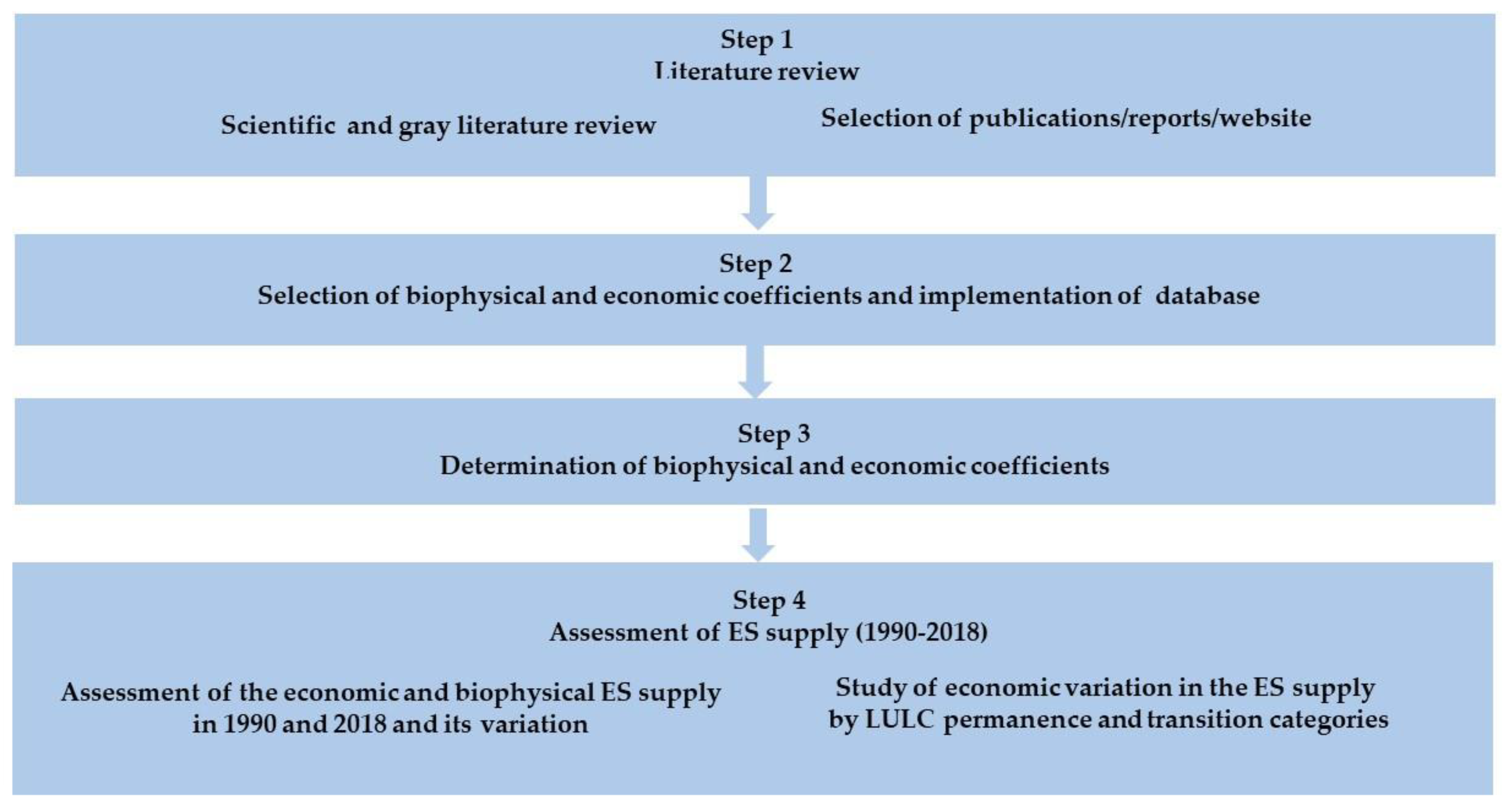
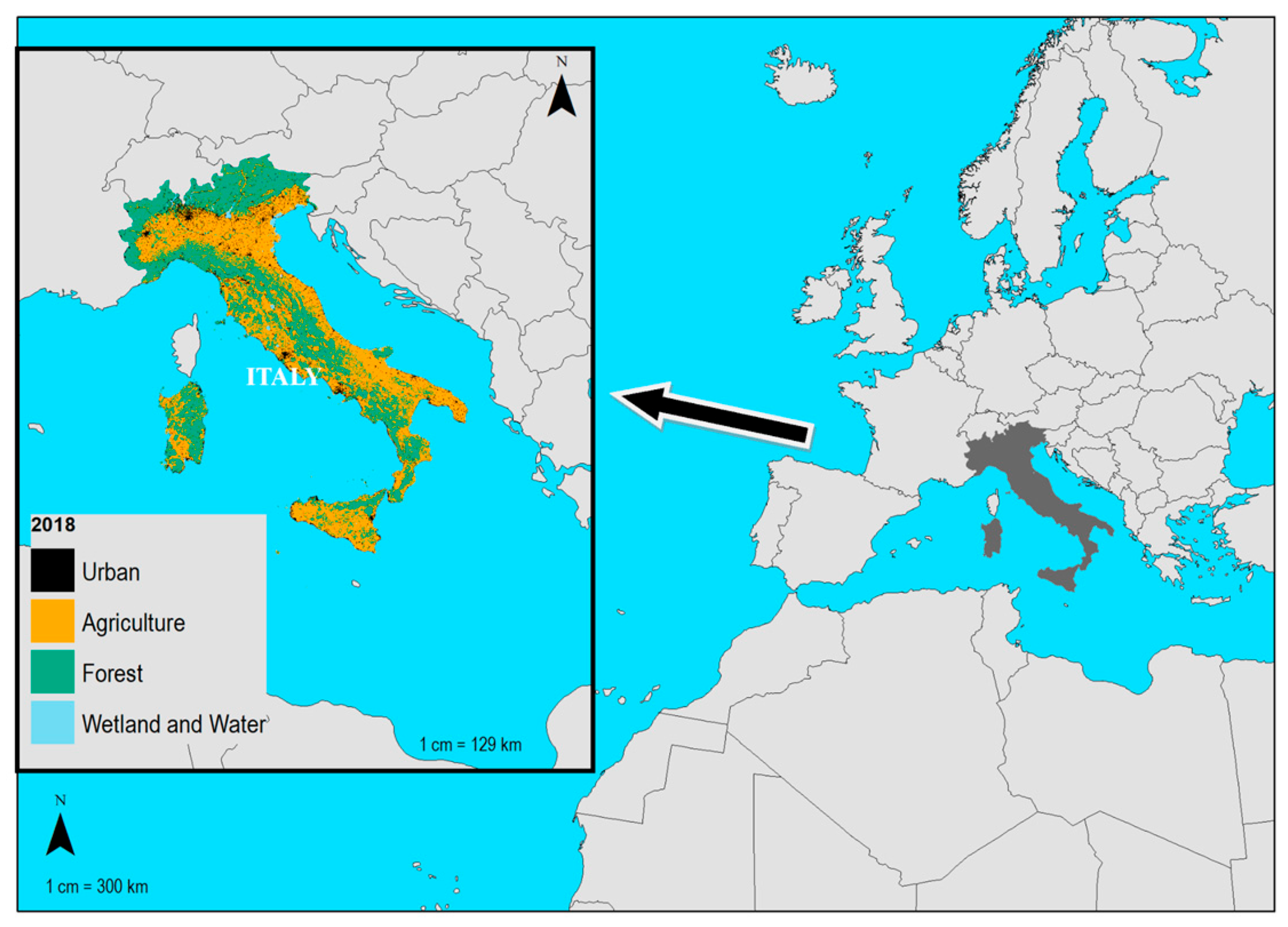
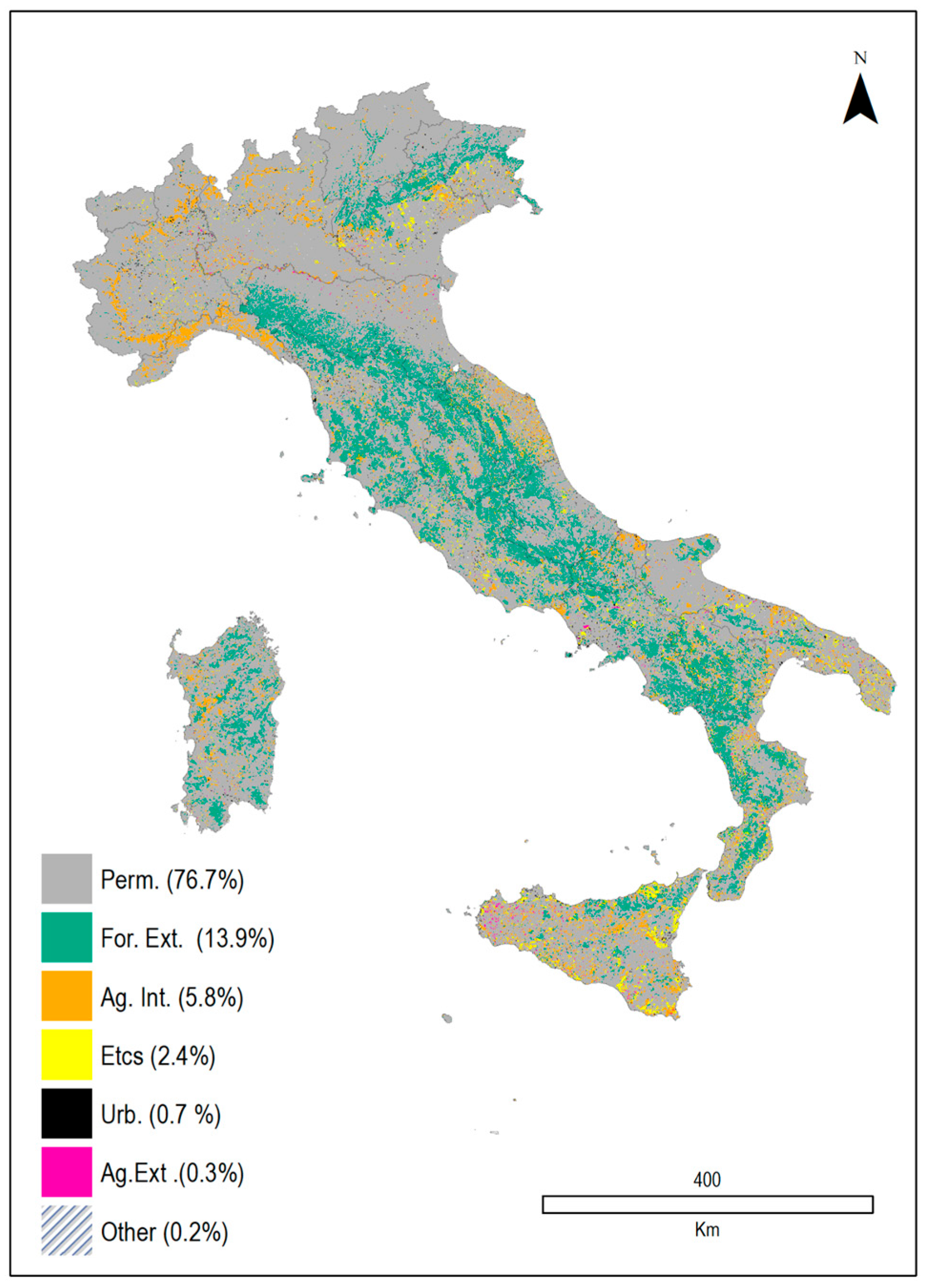

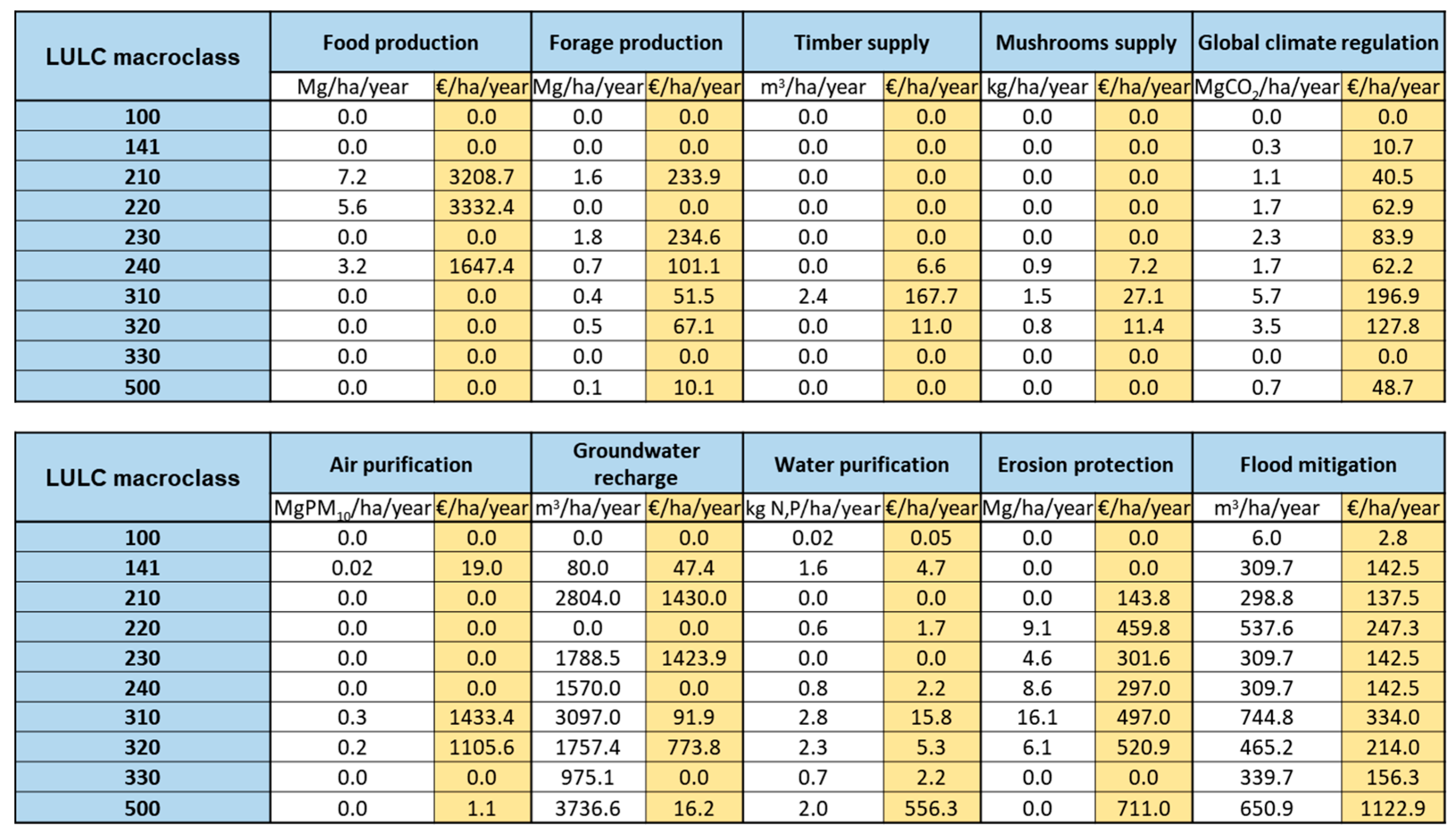

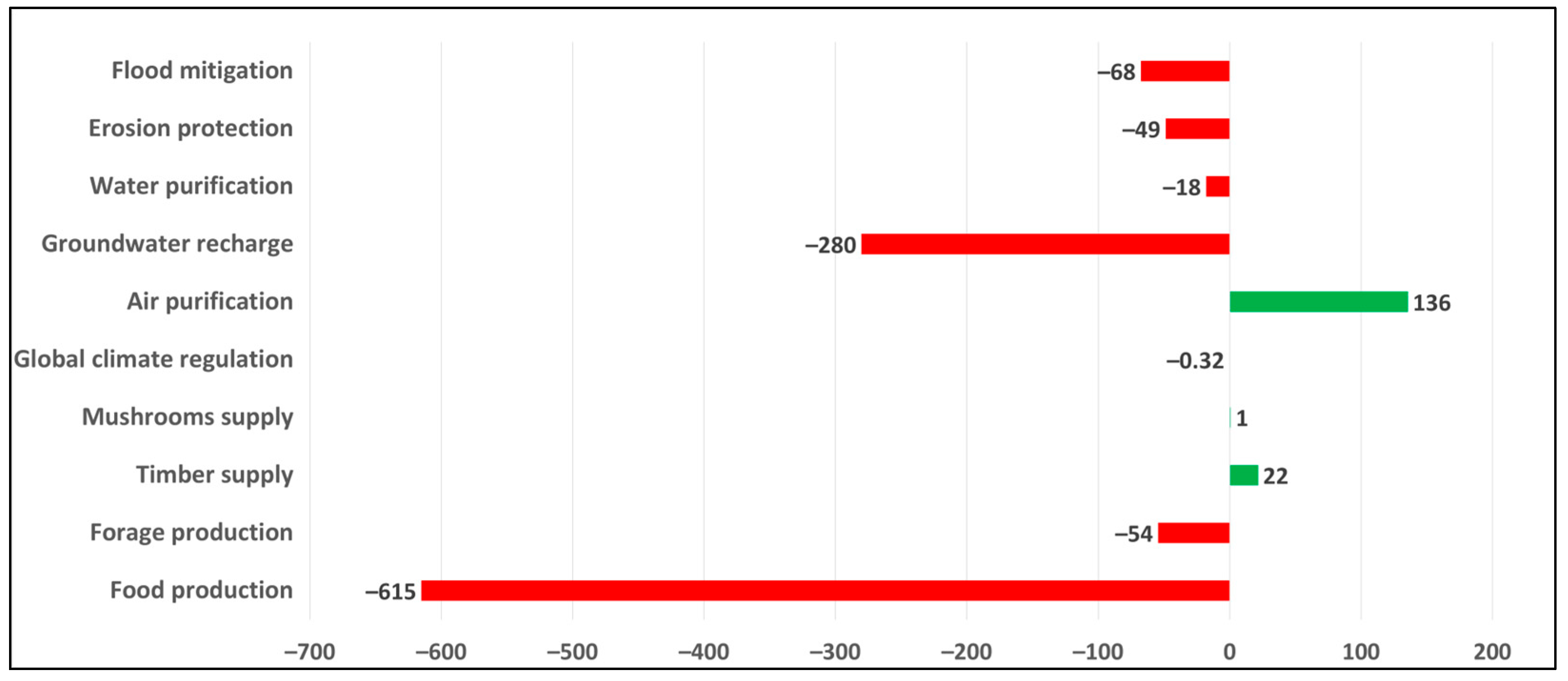
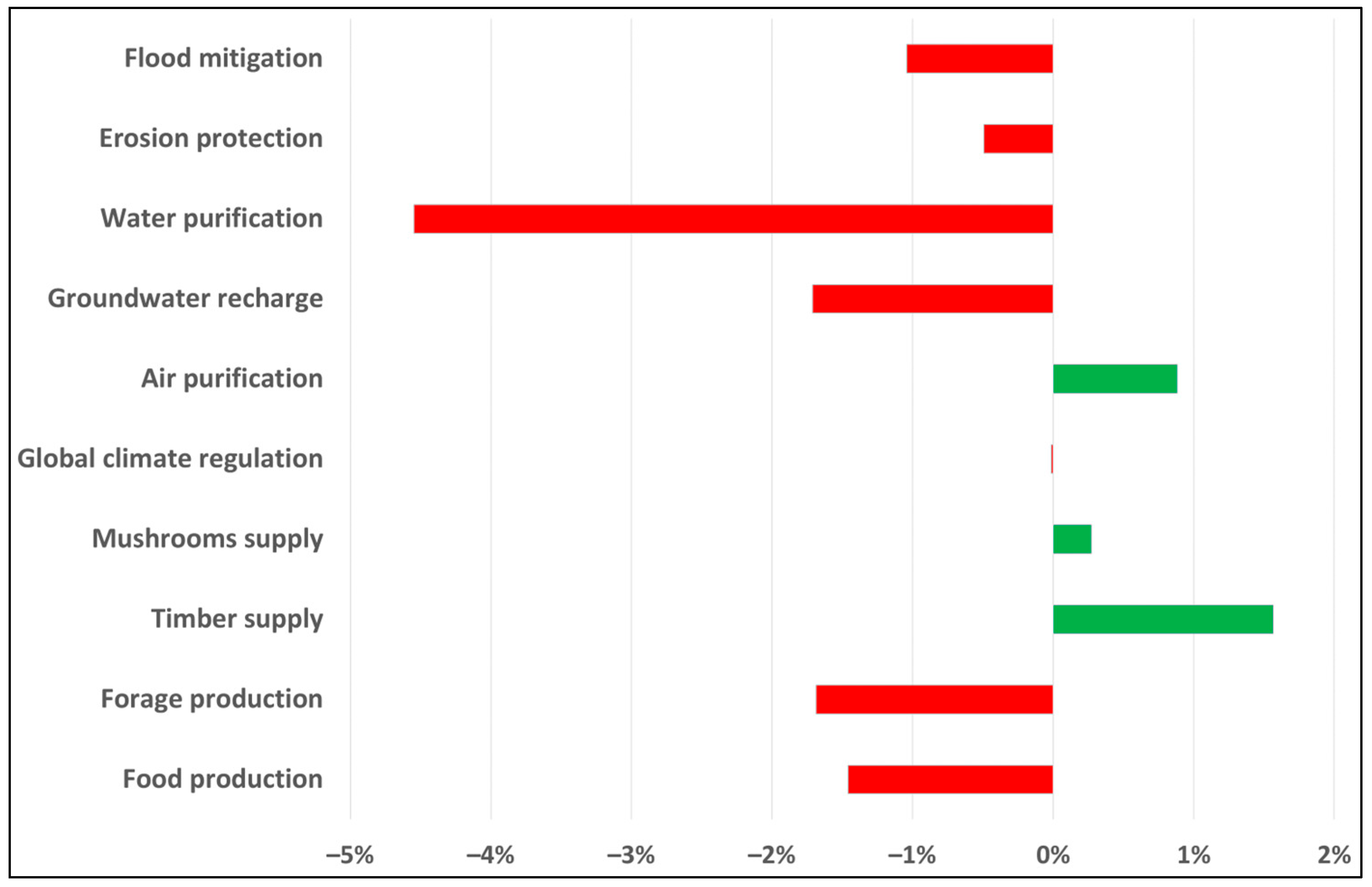
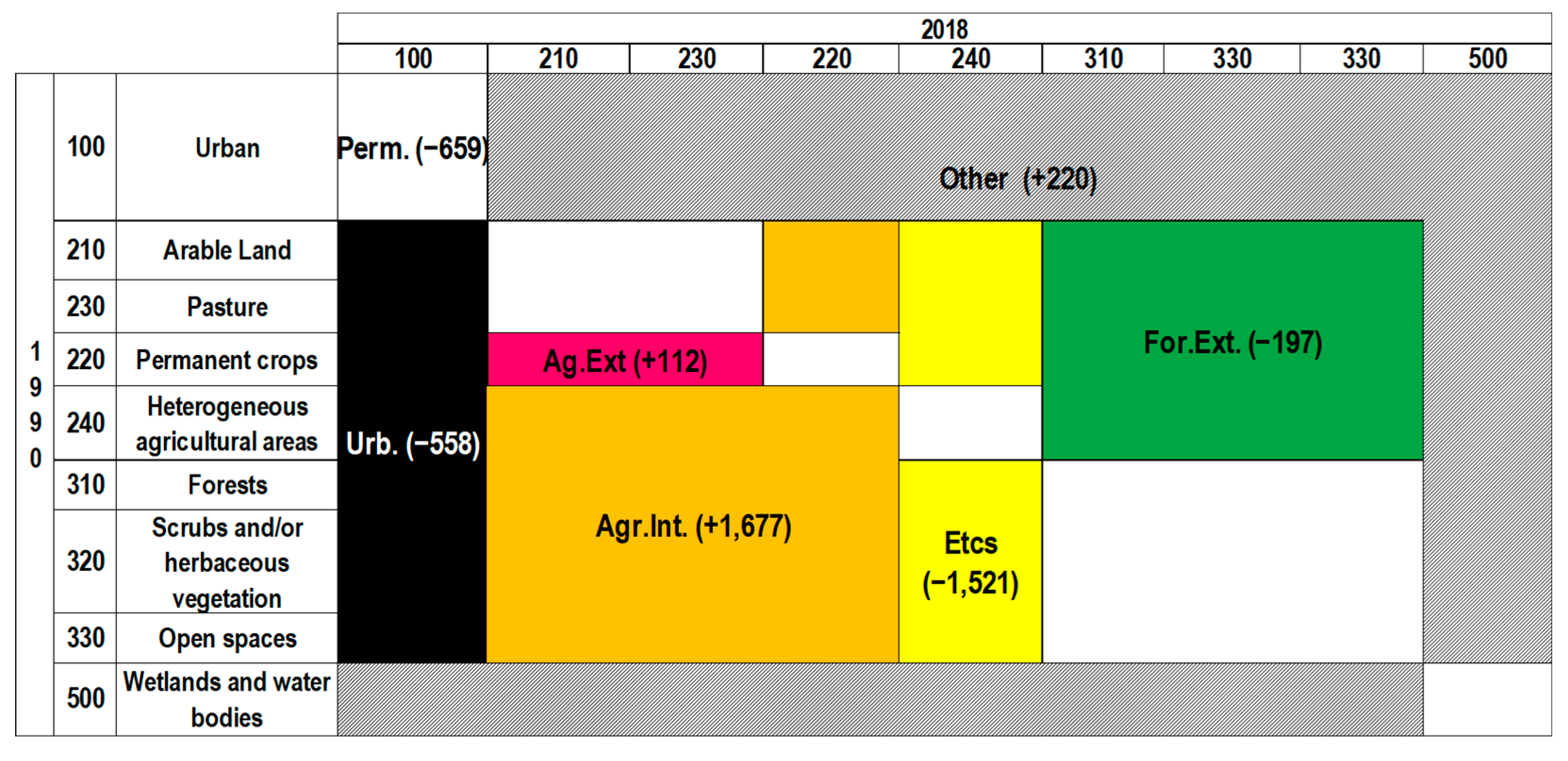
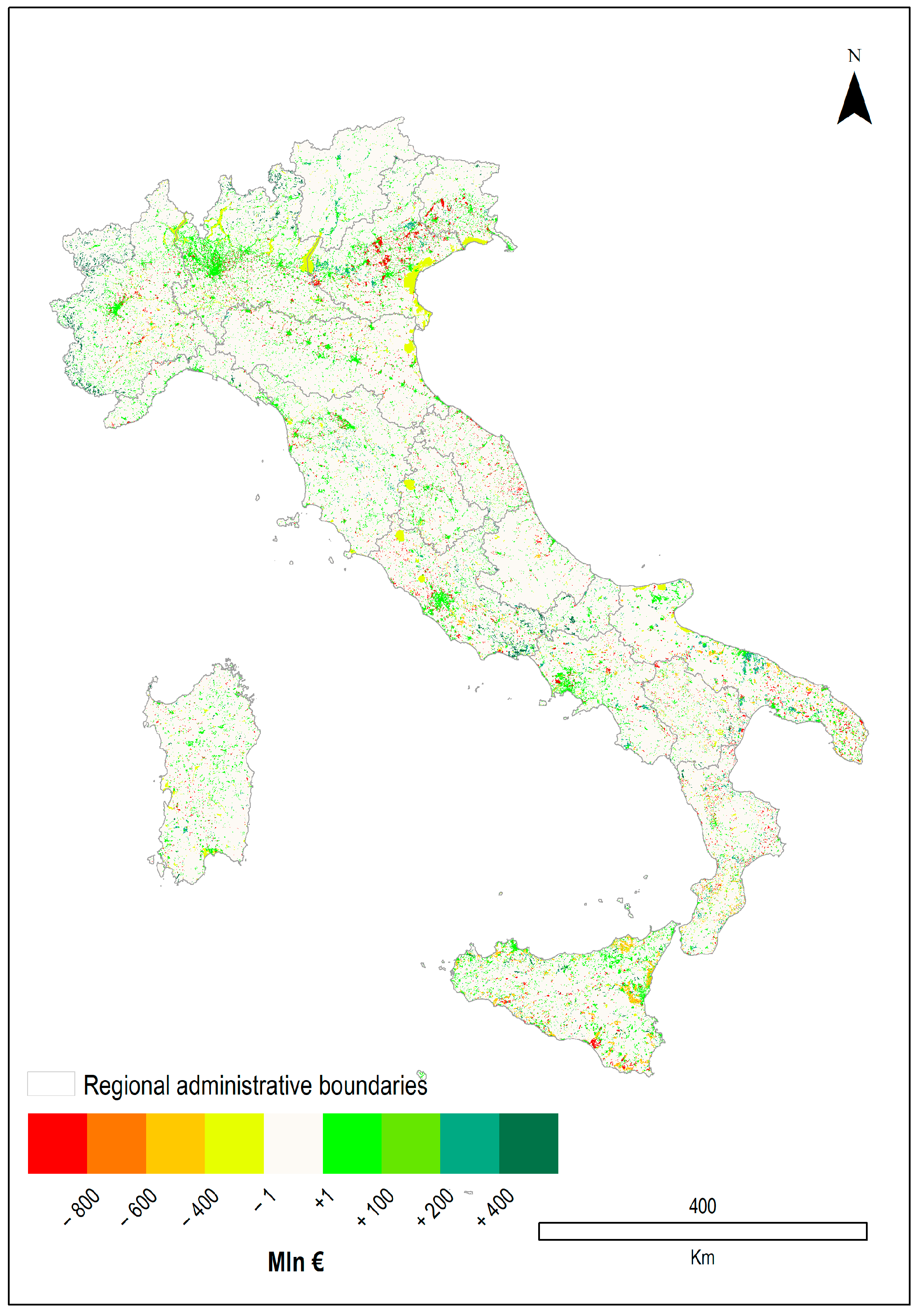
| Perm. | Urb. | Ag. Ext. | Ag. Int. | For. Ext. | Etcs | Other | Tot | |
|---|---|---|---|---|---|---|---|---|
| Food | −853 | −342 | 43 | 1883 | −653 | −822 | 129 | −615 |
| Fodder | −54 | −19 | 21 | 40 | −29 | −22 | 8 | −54 |
| Timber | 41 | −3 | −4 | −11 | 2 | −4 | 1 | 22 |
| Mushroom | 5 | −2 | −1 | −9 | 2 | 4 | 0 | 1 |
| Global climate regulation | 32 | −16 | −5 | −36 | 20 | −1 | 5 | 0 |
| Air purification | 462 | −34 | −31 | −475 | 278 | −77 | 12 | 136 |
| Groundwater recharge | −306 | −30 | 130 | 373 | 76 | −558 | 34 | −280 |
| Water purification | −14 | −2 | 0 | −3 | 1 | 0 | 0 | −18 |
| Erosion | 41 | −73 | −29 | −90 | 84 | −3 | 20 | −49 |
| Flood mitigation | −13 | −38 | −12 | 5 | 19 | −38 | 11 | −68 |
| Tot | −659 | −558 | 112 | 1677 | −197 | −1521 | 220 | −927 |
Disclaimer/Publisher’s Note: The statements, opinions and data contained in all publications are solely those of the individual author(s) and contributor(s) and not of MDPI and/or the editor(s). MDPI and/or the editor(s) disclaim responsibility for any injury to people or property resulting from any ideas, methods, instructions or products referred to in the content. |
© 2023 by the authors. Licensee MDPI, Basel, Switzerland. This article is an open access article distributed under the terms and conditions of the Creative Commons Attribution (CC BY) license (https://creativecommons.org/licenses/by/4.0/).
Share and Cite
Marino, D.; Barone, A.; Marucci, A.; Pili, S.; Palmieri, M. Impact of Land Use Changes on Ecosystem Services Supply: A Meta Analysis of the Italian Context. Land 2023, 12, 2173. https://doi.org/10.3390/land12122173
Marino D, Barone A, Marucci A, Pili S, Palmieri M. Impact of Land Use Changes on Ecosystem Services Supply: A Meta Analysis of the Italian Context. Land. 2023; 12(12):2173. https://doi.org/10.3390/land12122173
Chicago/Turabian StyleMarino, Davide, Antonio Barone, Angelo Marucci, Silvia Pili, and Margherita Palmieri. 2023. "Impact of Land Use Changes on Ecosystem Services Supply: A Meta Analysis of the Italian Context" Land 12, no. 12: 2173. https://doi.org/10.3390/land12122173
APA StyleMarino, D., Barone, A., Marucci, A., Pili, S., & Palmieri, M. (2023). Impact of Land Use Changes on Ecosystem Services Supply: A Meta Analysis of the Italian Context. Land, 12(12), 2173. https://doi.org/10.3390/land12122173











